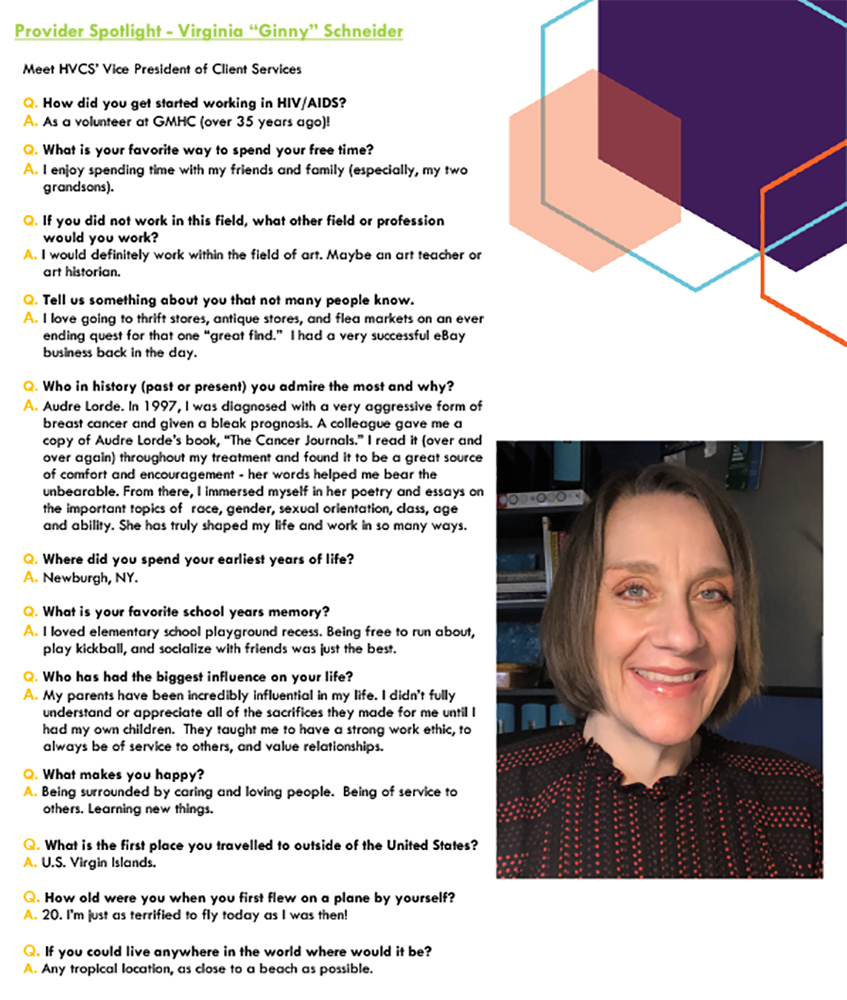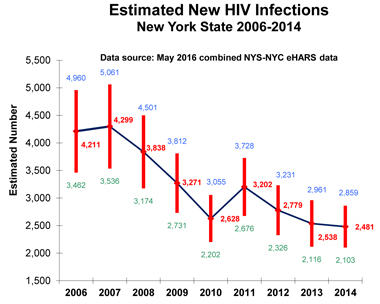Virginia “Ginny” Schneider, who is HVCS’ Vice President of Client Services, was featured in the April issue of the Bureau of Community Support Services’ newsletter. BCSS is part of the New York State Department of Health’s AIDS Institute. BCSS oversees many of our contracts with NYS. Congratulations, Ginny!
Posts Tagged ‘New York State’
Ginny Schneider, VP of Client Services, Featured in DOH Newsletter
Thursday, April 22nd, 2021Quarantine for Domestic Travel Dropped As of April 1
Tuesday, March 30th, 2021Governor Andrew M. Cuomo decreed that domestic travelers will no longer be required to quarantine after entering New York from another U.S. State or U.S. Territory starting April 1st. While no longer required, the NYS Department of Health still recommends quarantine after domestic travel as an added precaution. Mandatory quarantine remains in effect for international travelers. All travelers must continue to fill out the Traveler Health Form. Individuals should continue strict adherence to all safety guidelines to stop the spread – wearing masks, socially distancing and avoiding gatherings.
Updates to NYS Quarantine Guidelines
Wednesday, March 17th, 2021SUMMARY
This document provides updated guidance on quarantine for community persons exposed to COVID-19, and how to factor in a person’s vaccination status. This guidance does not apply to vaccinated inpatients and residents in health care settings.
•This guidance aligns the requirements for release from quarantine with the February 10, 2021 Centers for Disease Control and Prevention (CDC) guidance.
QUARANTINE REQUIREMENTS FOR INDIVIDUALS EXPOSED TO COVID-1
Consistent with recent CDC guidance, asymptomatic individuals who have been fully vaccinated against COVID-19 do not need to quarantine during the first 3 months after full vaccination, if the following criteria are met:
- Are fully vaccinated (i.e., ≥2 weeks following receipt of the second dose in a 2-doseseries, or ≥2 weeks following receipt of one dose of a single-dose vaccine); AND
- Are within 3 months following receipt of the last dose in the series; AND
- Have remained asymptomatic since last COVID-19 exposure.
Individuals who do not meet all 3 of the above criteria and who have been exposed to someone with confirmed or suspected COVID-19 are required to quarantine for 14 days after exposure, or ten days if they meet the criteria for a reduced quarantine. Consistent with previous CDC guidance, there is no testing requirement to end the quarantine if no symptoms have been reported during the quarantine period. However, a test should be sought immediately if any symptoms develop during the fourteen days after exposure.
Consistent with CDC guidance from February 13, 2021, asymptomatic individuals who have previously been diagnosed with laboratory confirmed COVID-19 and have since recovered, are not required to retest and quarantine within3 months after the date of symptom onset from the initial SARS-CoV-2 infection or date of first positive diagnostic test if asymptomatic during illness.
While COVID-19 vaccines have demonstrated high efficacy at preventing severe and symptomatic COVID-19, there is currently limited information on how much the vaccines might reduce transmission, how long protection lasts, and the efficacy of vaccines against emerging SARS-CoV-2 variants. Additionally, some individuals who were previously infected with COVID-19 have been reinfected at a later time. Therefore, regardless of quarantine status, all individuals exposed to COVID-19 must:
- Continue daily symptom monitoring through Day 14;
- Continue strict adherence to all recommended non-pharmaceutical interventions, including hand hygiene and the use of face coverings, through Day 14 (even if fully vaccinated);
- Immediately self-isolate if any symptoms develop and contact the local public health authority or their health care provider to report this change in clinical status and determine if they should seek testing.
TRAVEL AND QUARANTINE
Domestic travelers arriving in New York from non-contiguous US states and territories who are not essential workers and/or who did not complete the testing requirements described in Executive Order 205.2 must quarantine. Asymptomatic domestic travelers to New York can be exempted from quarantine if meet the criteria described previously in this document.
International travelers arriving in New York must comply with all CDC requirements for testing and quarantined after international travel. This requirement applies to all international travelers whether they were tested before boarding, are recovered from a previous COVID infection, or are fully vaccinated.
Consult the latest NYS travel advisory for more information. Guidance on how to quarantine can be found here.
LOCAL HEALTH DEPARTMENTS AND QUARANTINE ORDERS
Local Health Departments (LHDs) will continue to identify individuals who may have been exposed to COVID-19. Contact tracing interviews will now include questions about vaccination status and dates. Contact tracers may validate reports of vaccination status in NYSIIS or CIR, the statewide immunization registry, during the interview. Individuals who meet the vaccination criteria listed above do not need to quarantine. Information about the criteria for quarantine exemptions due to immunization status will be included in local quarantine orders from this point forward.
ADDITIONAL INFORMATION
This guidance applies only to asymptomatic individuals who have been exposed to COVID-19 and who have not tested positive as a result of a recent exposure. Individuals who test positive for COVID-19 must isolate. Information on the criteria and duration for isolation can be found here.
NYS Extends Open Enrollment To August 15, 2020
Friday, July 17th, 2020The Governor announced on Wednesday, July 15, 2020 that the Special Enrollment Period (SEP) for uninsured New Yorkers will be extended through August 15, 2020.
You can read the full press release at the following link:
HVCS In The News: Funding Freeze Puts Squeeze on New York Providers of Social Services
Friday, June 12th, 2020From the Wall Street Journal. View the original article here (paid subscription may be required)
Money is running out to help AIDS patients pay rents; schools are also on edge
Members of the New York City Department of Probation distributed food at a Bronx pantry in late April.
By Jimmy Vielkind
ALBANY, N.Y.—Social service providers say they are struggling as New York’s state government withholds grant payments in response to the novel coronavirus crisis.
Gov. Andrew Cuomo’s budget division froze payments to municipalities and nonprofit agencies, and withheld scheduled raises to some workers in April after revenues crashed as a result of the pandemic.
State revenues are $13.3 billion below expectations, according to the most recent estimate. The state has held up nearly $4 billion of payments, as the Democratic governor pushes Congress for more aid. The state also borrowed $1 billion last month to help it remain solvent until income tax payments, which were previously due in April, start arriving in July. Officials plan to borrow an additional $3.5 billion this week.
As the state holds on to cash, some providers said they are contemplating layoffs and other measures. ACR Health, a Syracuse-based nonprofit that services AIDS patients and others throughout central New York, relies on state grants for almost 88% of its $12 million annual budget, Executive Director Wil Murtaugh said.
Mr. Murtaugh said his group is owed more than $1 million for services that were performed. As a result, ACR has been unable to make rental assistance payments for 221 HIV-positive people in private facilities.
“I don’t think it’s smart to have immunocompromised people be homeless,” Mr. Murtaugh said in an interview. Mr. Cuomo, through an executive order, has put a moratorium on evictions through Aug. 20.
The U.S. House of Representatives, controlled by Democrats, last month approved $1 trillion in additional aid for state and local governments, including $35 billion for New York, as part of a $3 trillion economic relief package.
Republicans who control the Senate, however, are skeptical about sending money to states for expenses they see as unrelated to the pandemic. The Senate is expected to approve another relief bill by the beginning of August, with the size and scope of more assistance to states and municipalities set to be one of the central areas of contention between the parties.
ACR Health is part of a network of New York agencies created in the 1980s in response to the AIDS epidemic. Their mandate has subsequently expanded, said Andrea Straus, executive director of Hudson Valley Community Services Inc.
Her organization has 11 different state contracts that support the work of 71 of the organization’s employees. Ms. Straus said a loan through the federal Paycheck Protection Program has helped her organization avoid layoffs, but it will re-evaluate the situation this summer.
“Our staff are essential, but they’re not going to get paid? It seems so counterintuitive,” Ms. Straus said. “They owe us $908,634.40. And there’s about another $400,000 for May.”
Freeman Klopott, a spokesman for the state Budget Division, said the payment delays could translate into permanent reductions of 20%. “This is exactly why we have been calling on the federal government to provide the resources states need—without federal action, the most vulnerable among us will suffer,” he said.
School districts and municipalities are also on edge. The state was due to release $247 million of aid to Buffalo, Rochester and Syracuse on June 25, but Budget Director Robert Mujica previously told The Wall Street Journal that the grants wouldn’t be released without federal action.
“Uncertainty abounds,” said Peter Baynes, executive director of the New York State Conference of Mayors, which represents city and village leaders.
New York officials did provide clarity this week for road contractors when they allocated $544 million that will be sent to municipalities for paving. Frank Suits Jr., president of the Suit-Kote construction firm based in Cortland, N.Y., said he was preparing to lay off hundreds of workers who normally spend the summer working on road projects. He has now scrapped those plans.
Wyoming County High Superintendent Todd Gadd said even though money isn’t expected until later in the year, municipalities will now execute contracts and fix roads during New York’s limited summer construction season. The state warned, though, that the allocations could be reduced by 20%.
“It’s good we can get projects started, but there’s still that potential cut looming,” Mr. Gadd said.
For other organizations, the payment delays are closer to an annoyance than a cataclysm. Food Pantries for the Capital District, which helps transport food and supplies to 65 pantries in the Albany area, last year received a $15,000 state grant to fund the operation of an additional delivery truck.
Natasha Pernicka, the organization’s executive director, said the state is supposed to reimburse it $970 a month for lease payments. The group has had to eat the cost.
“A lot of organizations don’t have flexibility, and their cash flows are very tenuous,” Ms. Pernicka said. “The intention of donors right now is to pay for Covid response—not because we’re waiting for state payments to come through.”
NYS HIV Infections Reach Historic Low; More Funds for PrEP Announced
Thursday, July 14th, 2016In case you missed this week’s big news from Albany, Gov. Cuomo announced that estimates of new HIV infections for 2014 show a decrease of 41% from 2006. Estimated new HIV infections were fewer than 2,500 for the first time. The estimated HIV incidence rate (that is, the rate of people living with HIV, per 10,000 residents) fell 43% since 2006.
New estimates also report that 123,000 New Yorkers live with HIV, as of the end of 2014. About 10,000 do not yet know they are HIV-positive (8%). While this is good news overall, the report also estimates that only 62% of HIVers are virally suppressed (they have an undetectable viral load) and are, theoretically, incapable of infecting others. NYS would like to increase this percentage while continuing to decrease new infections to less than 750 per year by 2020.
Gov. Cuomo also announced an additional $4 million in funding to spread awareness of PrEP (pre-exposure prophylaxis). The NYS Department of Health unveiled new videos to educate the public about PrEP and a new website, PrEPforSex.org.
HVCS offers PrEP referrals, information and support, so please contact us if you’re thinking about going on PrEP to stay safe from HIV. These are trends we want to see continue!



